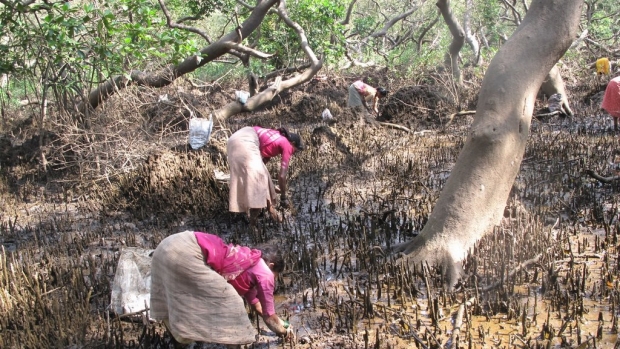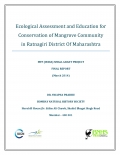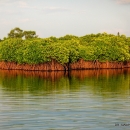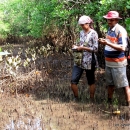Grants :: Small Grant Facilities :: Ecological assessment and education for conservation of mangrove community in Ratnagiri district, Maharashtra
Ecological assessment and education for conservation of mangrove community in Ratnagiri district, Maharashtra

Collection of Cardium sp. (clams) a regular activity in man ... , Bhopan Ratnagiri, Maharashtra, India © Swapna Prabhu, 2012
Objectives
The objectives of this project were to:
- Document the ecological status of mangrove plant communities in Ratnagiri, Maharashtra
- Awareness generation and education for restoration and conservation of mangroves
- Develop a guide to the mangrove plant species in Ratnagiri, Maharashra
Background
The project represents conservation issues of mangroves in the Ratnagiri District of Maharashtra. The area is well known for its dense mangroves yet not studied in detail till present. During the last 25 years, about 40% reduction in the mangrove cover of Maharashtra has been due to human interference. Recently, various industries including power project are set to be developed in this region. In light of these developments, it is needed to undertake a comprehensive assessment of mangrove habitats of this region along with awareness for conservation and improvement of degraded mangrove ecosystems along these coasts.
Majority of the mangrove forests of Maharashtra have vanished due to anthropogenic pressures in the recent years. During the last 25 years, about 40% reduction in the mangrove cover of Maharashtra has been due to human interference. Wood felling and habitat conversion under tremendous pressure of urbanization and industrialization are the two major threats observed for the mangroves of Maharashtra. Pollution of the rivers and creek water due to the industrial and sewerage discharge is another serious factor along the coastal belt of Maharashtra. At least fifteen proposed coal-fired power projects equaling 25 GW of power are set to be built on a narrow strip of coastal land 50 to 90 km wide and 200 km long. Power plants require their own captive ports for the transport of raw material. Thus there are number of minor ports proposed to come up in this area. Needless to say that ancillary development bound to take place which is not necessarily envisaged in the proposed project impacts. Besides, thermal power plants and minor ports and jetties, the coastal areas are dotted with numerous aquaculture farms which have come up at the cost of mangroves and most probably without any legal clearances. Unfortunately, lot of coastal mangrove areas in Konkan are privately owned thus it is not surprising to find many of these areas are easily available for sale. Western Ghat areas of Konkan are now witnessing mining activities as well. There are already few operational mines. Number of new mines are proposed in these areas.
Coastal tourism is catching up very fast in the coastal Konkan. Number of coastal resorts have come up in this region of which one or two resorts are in total violation of Coastal Regulation Zone. It is evident from the baseline survey carried out by BNHS (Apte & Bhave 2010), that if looked in totality, there is not a single sq km area free of impact in the stretch of about 200 km of coastal Konkan from Dabhol to Sindhudurg.
Target beneficiaries
Scientific researcher and coastal zone managers
Outputs
The project aimed to document the ecological status and existing, as well as potential future threats, to the mangrove plant communities in the Ratnagiri District of Maharashtra. Surveys will be conducted in the selected sites to analyze parameters such as species richness, community structure and floral species distribution patterns across biotic and abiotic factors. Based on the collected data, distribution maps will be produced.
The project further aimed to empower local communities to conserve the mangroves through awareness and education programmes. Meetings with stake holders and Village Governing Bodies will be conducted to create platforms for the sharing of experiences and problems encountered in the conservation of mangroves at the ground level. Further to this a demonstration plot will be developed with local community participation for the restoration of mangrove areas. Approximately 10,000 saplings will be raised in a mangrove nursery; it is expected that at least four acres of suitable land will be restored.
This programme is an effort to increase awareness of mangroves in Maharashtra in scientific circles, as well as local communities. Although a short term project, it will establish the initial steps towards future mangrove conservation in the region.
Accomplishments and challenges
The floristic explorations are constantly subject to new discovery, addition and deletion of species from the mangrove database of Maharashtra. Due to the restricted contribution of plant taxonomists, the systematic enumeration of mangroves is seldom mentioned in the literature and the aspect of identification is generally taken for granted in most of the ecological works. Limitations to the field work, wide distribution and adaptation of the species are responsible for the taxonomic uncertainties despite their apperent familaritry. As the mangroves belong to different families, the phenological stages change according to the species and the researchers are unable to find a single season to study the characters of a species. Therefore, frequent field visits and laboratorical observations become necessary in the process of identification of mangroves. Some of the earlier publications have produced erroneous species list due to the mis-identification or nomenclatural changes. From the table it is clear that species Bruguiera parviflora, Sonneratia acida, Acanthus ebracteatus, Acanthus volubilis, Lumnitzera coccinea, Xylocarpus moluccensis and Xylocarpus mekongensis are not recorded afterwards or their occurrence in the study area is dubious. Surprisingly, Sonneratia alba which is very distinct species and common at the mouth of all major estuaries was not mentioned in any of the State Flora of BSI and Almeida..
The present floristic analysis of mangroves along the Maharashtra coast reveals 18 true mangrove species with one variety (Table 4.2a) and 15 frequent associates. The mangrove species belongs to 12 genera from 9 families. The family Rhizophoraceae dominates with 7 species representing 4 genus followed by Sonneratiaceae and Avicenniaceae with three species each. Myrsinaceae, Combretaceae, Acanthaceae, Euphorbiaceae, Meliaceae and Fabaceae represent single genus and species. Avicennia, which is taxonomically most confusing genus, has two distinct species and a variety.
The awareness and education programmes included 17 schools and five villages in the Ratnagiri districts. The nature of the programmes was common for schools and villages or governing bodies. The schools were open to readily participate in such programmes. Maharashtra State Education Board syllabus for secondary schools included lessons on mangrove ecosystem and their conservation in the Environmental Science which was taught as a separate subject till last academic year (2011-2012). However, the subject merely exists as three additional lessons in the text book of General Sciences which includes a paragraph on mangrove ecosystems. Most of the schools appreciated the programmes conducted by BNHS as students and even teachers got an opportunity of the subject exposure. However, it was very difficult to approach and gather villagers together for any activity mostly due to their pre-occupations and partially due to lack of interest. On the other hand the villages which readily allowed to take the programmes in their villages were very proactive and eager to respond. The villages which participated in programmes were Umroli, Bhopan, Tiwre, Juve and Aade.
Contributions to cross-cutting themes
The project findings can advise future plantation interventions that Governments and other stakeholders will undertaken in fulfillment of various targets related to climate change, reforestation, and conservation. The study can also advise decision-makers in natural resource planning
Lessons Learned
BNHS set up a small nursery at Village Kasari for last three years, where around 10,000 saplings were grown. The plot was a small part of an agricultural field close to the mangrove area occasionally flooded by tidal waters. The tidal water feeding this area is controlled by the dyke constructed about 30 years ago, with a few of its flood gates open. Unfortunately all these floodgates except two were closed last year by “Kharland Development Board” authorities, which resulted in stopping the tidal water from entering in the agricultural plots. Around 5000 saplings of three year age withered away due to stopped water supply. Consequently 10000 mangrove saplings were grown on the creek side of the mangrove patches. In the beginning of April all the flood gates were closed resulting in drying up of 100 ha mudflat surrounded by mangroves. The tidal water was confined to a shallow patch app. 200m from the nursery. Since there was no other source of water nearby, the only option was to dig trenches from subsided water level till nursery. This worked out well and the nursery was saved. However, it took a lot more time than scheduled for the establishment of the nursery. Consequently plantation programme was carried out in the month of December (2013) with the help of villagers of Kasari village, especially, Women’s Self – Help Group there. App. 5000 saplings were planted along the bund constructed by Kharland Development Board.
It was realized through this project, that although immediate considerations such as identifying suitable land (and freshwater sources) and acquiring necessary approvals were addressed, other factors including political, political factors can prevent implementation of a project in a significant way.
Project Facts
Country
Location
Ratnagiri mangroves, Maharastra, India
Topic
- Knowledge management and communications
- Gender equality
- Climate change
- Marine Protected Areas
- Integrated Coastal Planning
- Coastal Governance
- Community Resilence
- Capacity Building
- Strategies for Management
- Knowledge for Management
Duration
15th May 2012 to 30th Nov 2013
MFF Grant Amount
INR 868,500
Co-financing Partner
Co-financing from BNHS: INR 133,000
Co-financing from local communities: INR 20,000
Implementing Partner
Dr. Swapna Prabhu
Systematic Botanist/ Taxonomist
Bombay Natural History Society (BNHS)
swapnaprabhu@gmail.com
Related Images
Related Publications

Ecological Assessment and Education for Conservation of Mangrove Community in Ratnagiri District Of Maharashtra
BNHS SGF project - Final Report
Author: Bombay Natural History Society (BNHS)
Publisher: MFF India
Posted on: 2nd Sep 2014
Category: SGF (Small Grant Facility)
Size: 3.4 MB


